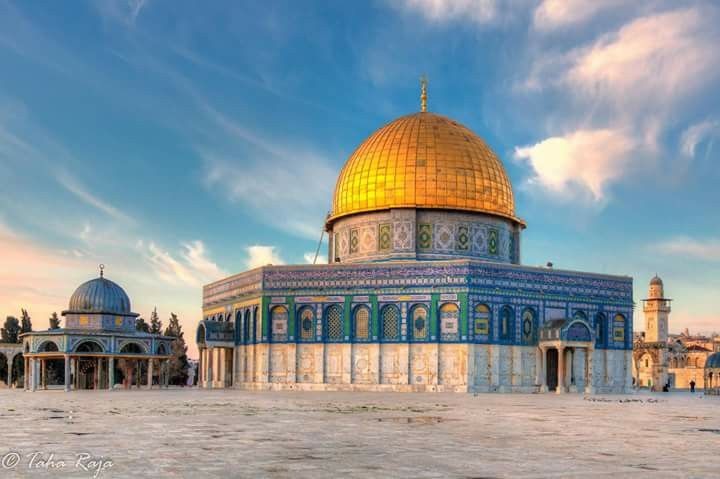Islam has a rich history filled with events that shaped its beliefs and practices. One major event is the change in the Qiblah, the direction Muslims face during daily prayers.The qibla (Arabic: قِبْلَة) is the direction toward the Kaaba in Mecca’s Sacred Mosque. Muslims use this direction in various religious contexts, especially for prayer (salah). Before the change, Muslims used to faced Masjid al-Aqsa in Jerusalem for prayers. However, after verse 144 of Surah Al-Baqarah was revealed in the 2nd Hijri year, the Qiblah was redirected to the Kaaba in Mecca. This change is seen as a significant event in Islamic history.
The Qibla Transition in Islam
The change of the qibla (Arabic: تحويل القبلة) refers to the event where the direction for Muslim rituals was shifted from the al-Aqsa Mosque in Bayt al-Maqdis (Jerusalem) to the Kaaba in Mecca. The change of the qibla occurred in the month of Rajab 2nd year of Hijri, around 624 CE. This event took place in the city of Madinah, after the revelation of verse 144 of Surah Al-Baqarah. After the qibla direction was changed, the Kaaba in Mecca became the central focus of worship for all Muslims, highlighting the importance of this holy site in Islamic practice.
Baitul-Maqdis (Masjid-Al-Aqsa): The first Qibla
In the early years of Islam, Muslims prayed facing Baitul-Maqdis in Jerusalem. This direction was initially chosen in alignment with earlier religious traditions. Even after the Prophet Muhammad (saw) migrated to Madina, Muslims continued to face Jerusalem for seventeen months. This period established a connection between Islam and previous Abrahamic faiths.
Verse of Qibla in the Quran
The verse that signifies the change in the direction of the qibla is found in Surah Al-Baqarah, verse 144. In this verse, Allah addresses the Prophet Muhammad (PBUH), acknowledging his anticipation for a change in the direction of prayer:
قَدْ نَرٰى تَقَلُّبَ وَجْهِكَ فِی السَّمَآءِۚ-فَلَنُوَلِّیَنَّكَ قِبْلَةً تَرْضٰىهَا۪-فَوَلِّ وَجْهَكَ شَطْرَ الْمَسْجِدِ الْحَرَامِؕ-وَ حَیْثُ مَا كُنْتُمْ فَوَلُّوْا وُجُوْهَكُمْ شَطْرَهٗؕ-وَ اِنَّ الَّذِیْنَ اُوْتُوا الْكِتٰبَ لَیَعْلَمُوْنَ اَنَّهُ الْحَقُّ مِنْ رَّبِّهِمْؕ-وَ مَا اللّٰهُ بِغَافِلٍ عَمَّا یَعْمَلُوْنَ(144)
“Indeed, We see the turning of your face to the heavens, so We shall surely turn you to a qibla which you shall like; turn then your face towards the Sacred Mosque, and wherever you are, turn your faces towards it.” (Quran 2:144).
This verse marks a pivotal moment in Islamic history when Allah commanded the shift of the qibla, or direction of prayer, from Al-Aqsa Mosque in Jerusalem to the Kaaba in Mecca.
The Historic Moment of Qiblah Change at Masjid-e-Dhul Qiblatain
The actual change of qiblah occurred during a congregational Zuhr prayer when Angel Jibraeel (as) brought the divine command to shift the direction to the Ka’bah, as stated in verse 144 of Surah Al-Baqarah. The Prophet Muhammad (saw) immediately followed this command, turning towards the Ka’bah in Mecca while still in the middle of prayer. This transition happened at Masjid-e-Dhul Qiblatain, or “The Mosque of the Two Qiblas,” which is notable for having two mihrabs: one facing Baitul-Maqdis and the other facing the Ka’bah, highlighting its historical importance.

Allah’s Response to Criticism on the Change in Qiblah Direction
When the direction of the qiblah was changed from Masjid al-Aqsa in Jerusalem to the Ka’bah in Mecca, it drew criticism and mockery from some groups, particularly the Jews and the hypocrites. They questioned why the Muslims had turned away from their previous qiblah. In response, Allah revealed verse 142 of Surah Al-Baqarah:
سَیَقُوْلُ السُّفَهَآءُ مِنَ النَّاسِ مَا وَلّٰىهُمْ عَنْ قِبْلَتِهِمُ الَّتِیْ كَانُوْا عَلَیْهَاؕ-قُلْ لِّلّٰهِ الْمَشْرِقُ وَ الْمَغْرِبُؕ-یَهْدِیْ مَنْ یَّشَآءُ اِلٰى صِرَاطٍ مُّسْتَقِیْمٍ(142)
“Foolish people will ask, ‘What has turned them away from their qiblah to which they were accustomed?’ Say, ‘To Allah belongs the East and the West; He guides whom He wills to a straight path.’”
This verse highlights that the direction of worship is a matter decided by Allah alone. As He is the Creator of the entire universe, including the east and the west. The change in qiblah was a test of faith and a means to distinguish true believers from those whose faith was weak or insincere. Allah guides whom He wills to the straight path, underscoring that true guidance comes only from Him.
Reasons behind the Qibla transition
There are several reasons for the change in the qiblah direction:
Separation from Idolatry:
Initially, the Prophet (PBUH) faced Al-Aqsa during namaz (prayer) to distinguish Muslims from the idol-worshippers in Mecca. By changing the qiblah to the Kaaba, which had once been a center for idol worship, Islam reinforced its distinct identity. And its spiritual independence from pre-Islamic practices.
Encouragement for Conversion:
The change was also intended to attract the people of the Arabian Peninsula to Islam. The Kaaba, a revered site among Arabs, provided a focal point. That aligned with their cultural and religious heritage, potentially drawing more people towards the new faith.
Addressing Concerns and Criticism:
Some Muslims worried that their previous worship facing towards Al-Aqsa might become invalid. To address these concerns, Allah revealed,
(143)وَ مَا كَانَ اللّٰهُ لِیُضِیْعَ اِیْمَانَكُمْؕ-اِنَّ اللّٰهَ بِالنَّاسِ لَرَءُوْفٌ رَّحِیْمٌ
“And Allah would never let your faith go to waste. Indeed, Allah is Most Merciful and Compassionate to the people.”
This reassured the believers of the validity of their previous worship.
Response to Criticism:
The shift addressed criticisms from the Jewish community and polytheists who mocked the Muslims for sharing their qiblah. By establishing the Kaaba as the new qiblah, Islam distinguished itself more clearly from these groups, emphasizing its unique path and divine guidance.
The Divine Command
Surah Al-Baqarah, verse 144, vividly describes the change of the qiblah from Al-Aqsa Mosque to the Kaaba.
“Indeed, We see the turning of your face to the heavens. So We shall surely turn you to a qibla which you shall like; turn then your face towards the Sacred Mosque, and wherever you are, turn your faces towards it.” (Quran 2:144).
This verse highlights the moment when Allah commanded the Prophet Muhammad (PBUH) to shift the direction of prayer to Kaaba.
The Prophet’s Anticipation
The Prophet Muhammad (PBUH) looked towards the heavens, anticipating divine instructions regarding the qiblah. This act was a sign of his hope and readiness for a new revelation from Allah. His gaze towards the sky showed his eagerness for Allah’s promise. He awaited the change of the qiblah, as mentioned in the Quran.
You can also read about
Salat al-Istikhara: A Guide to Seeking Divine Guidance
Khamr in Islam: Why Alcohol is Forbidden?
